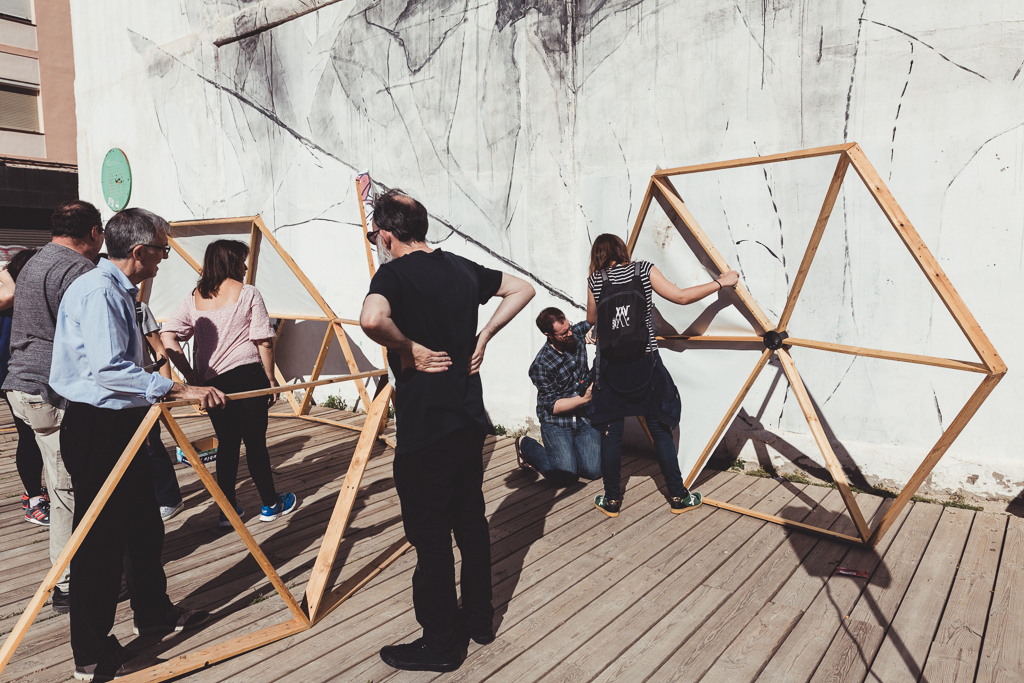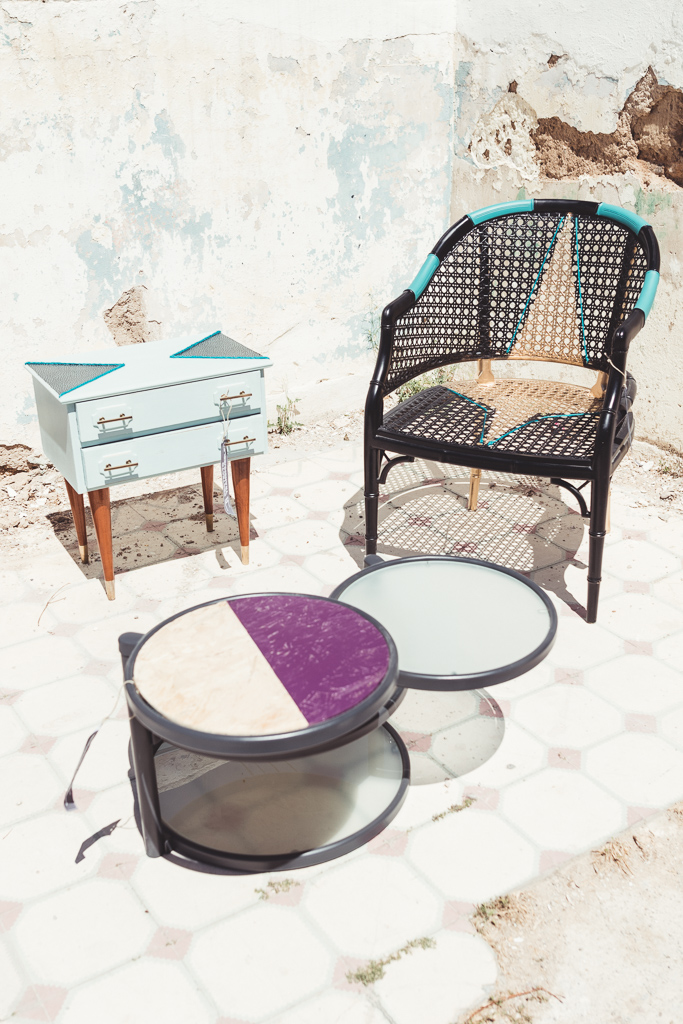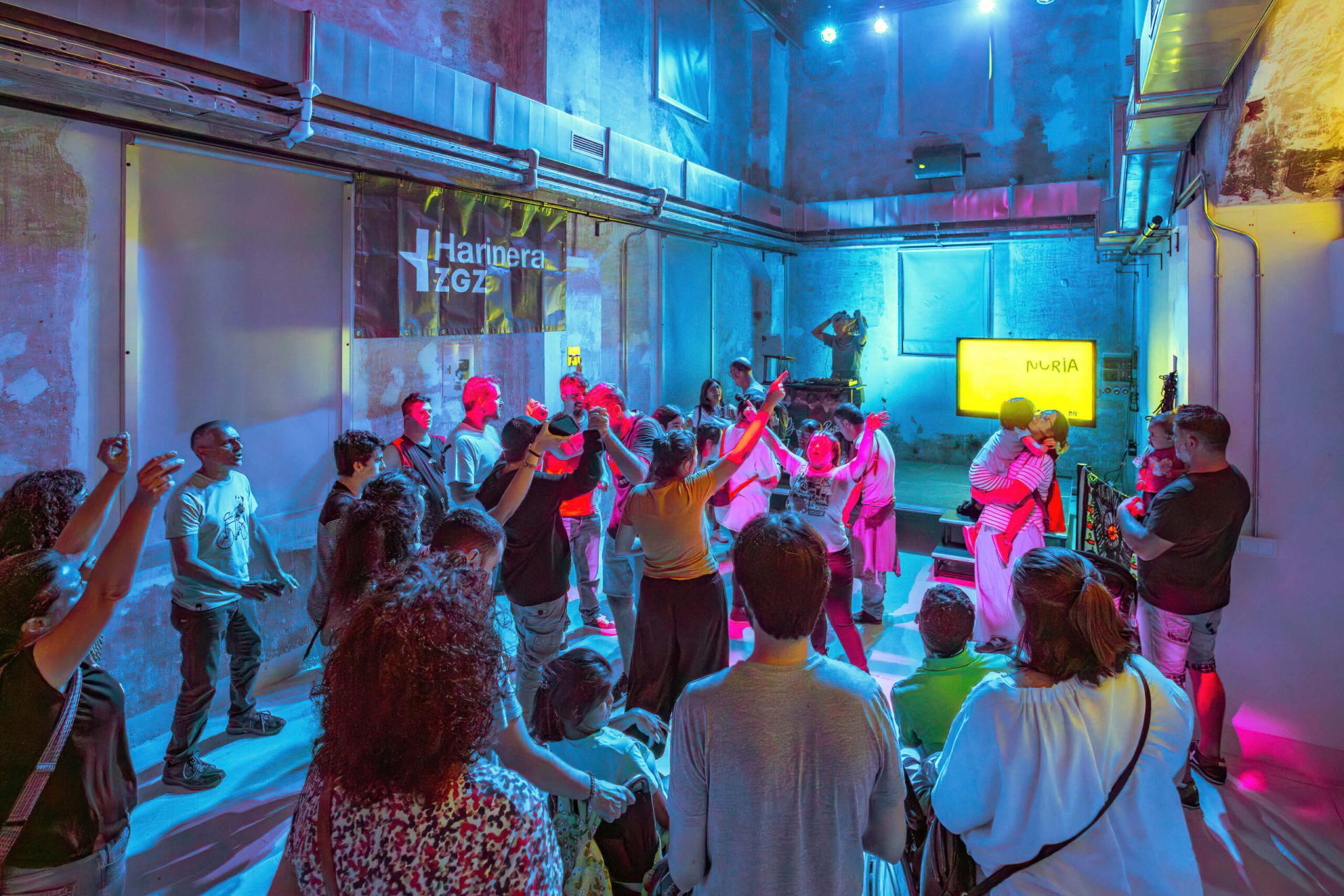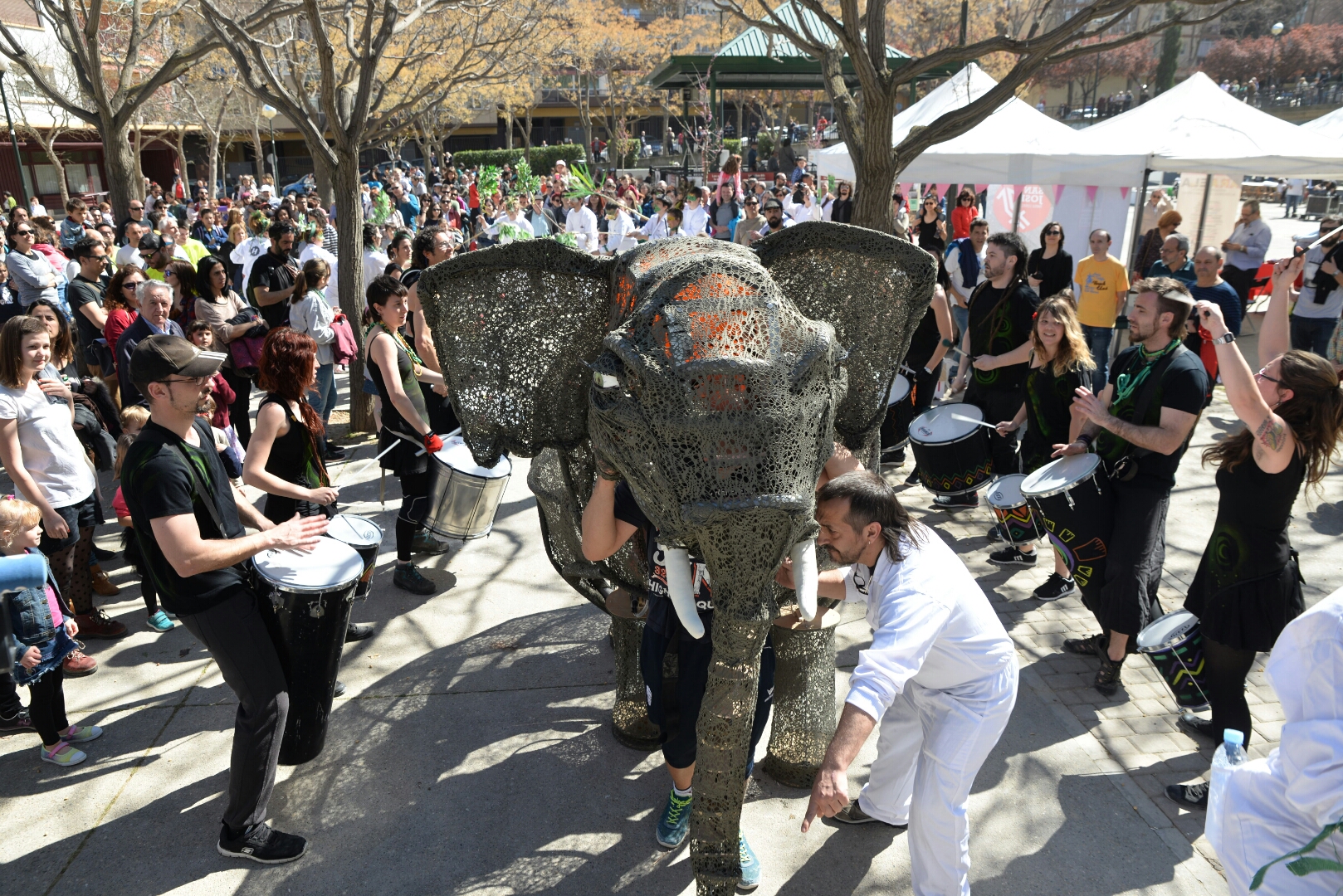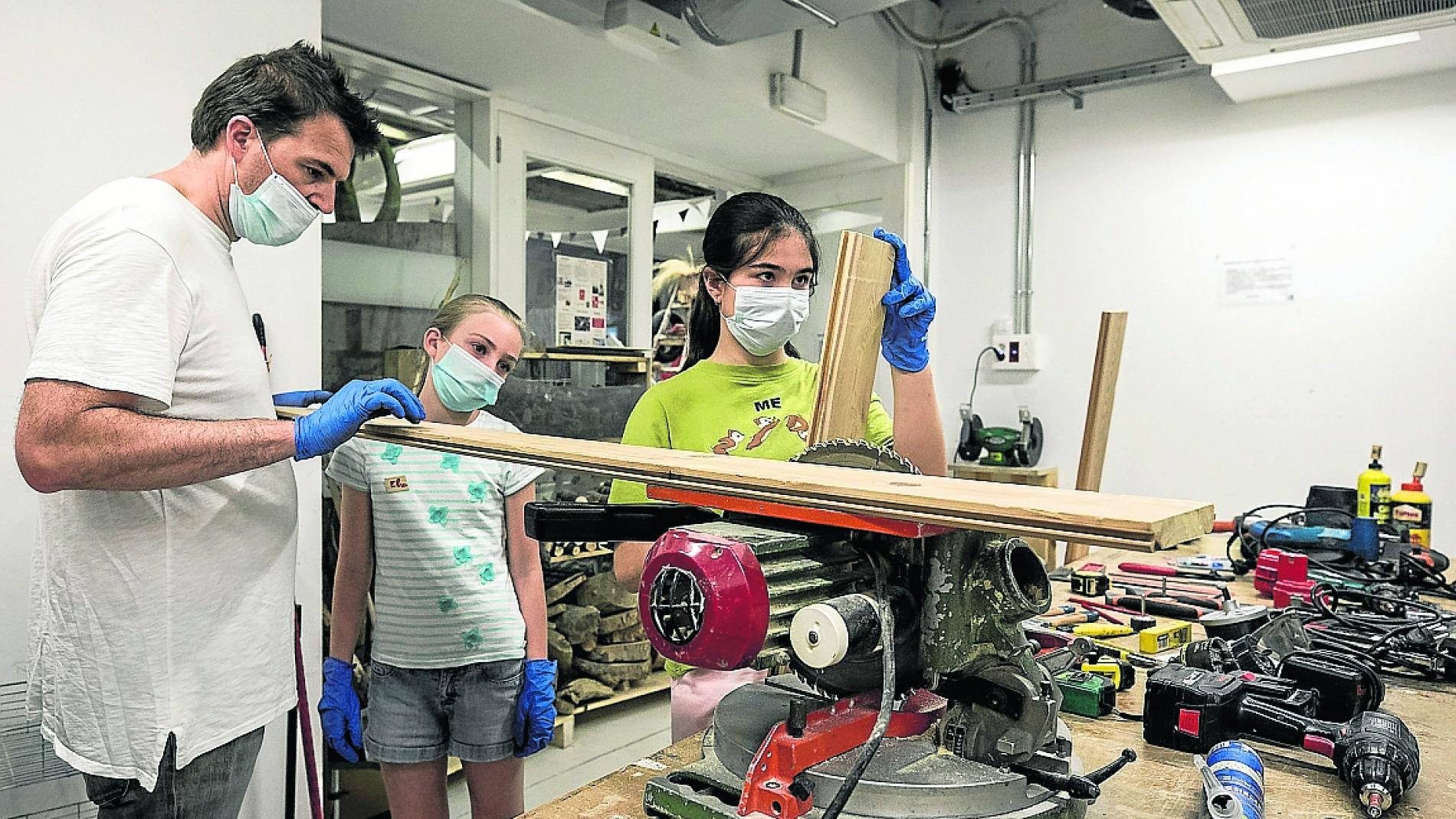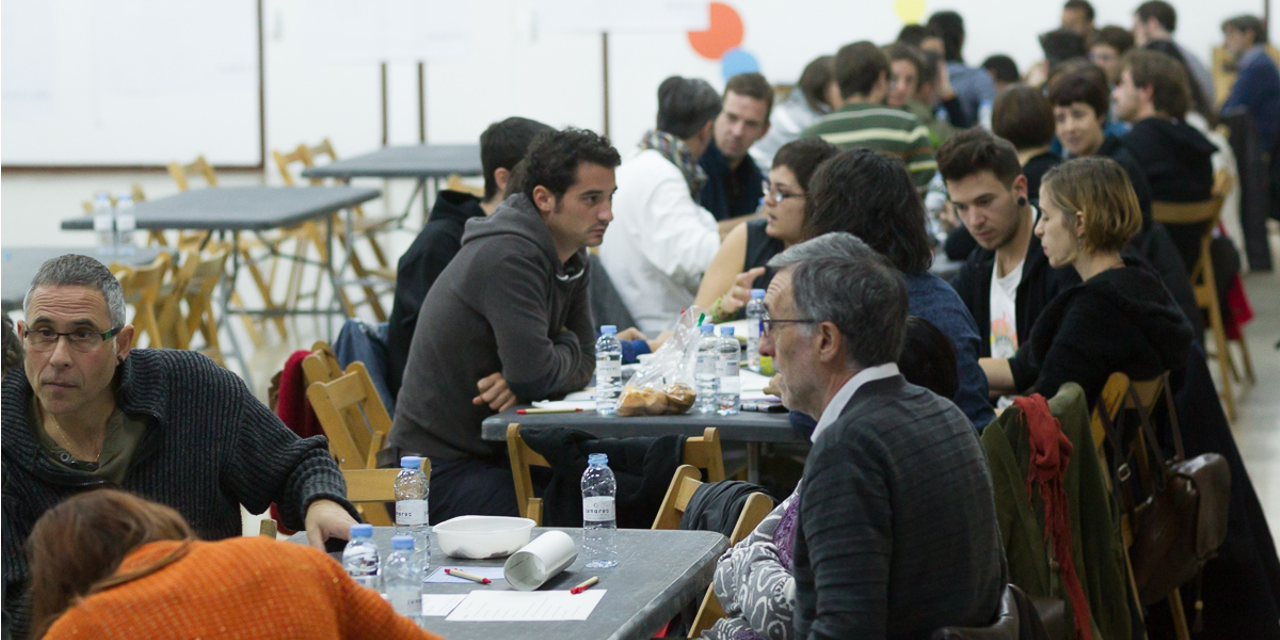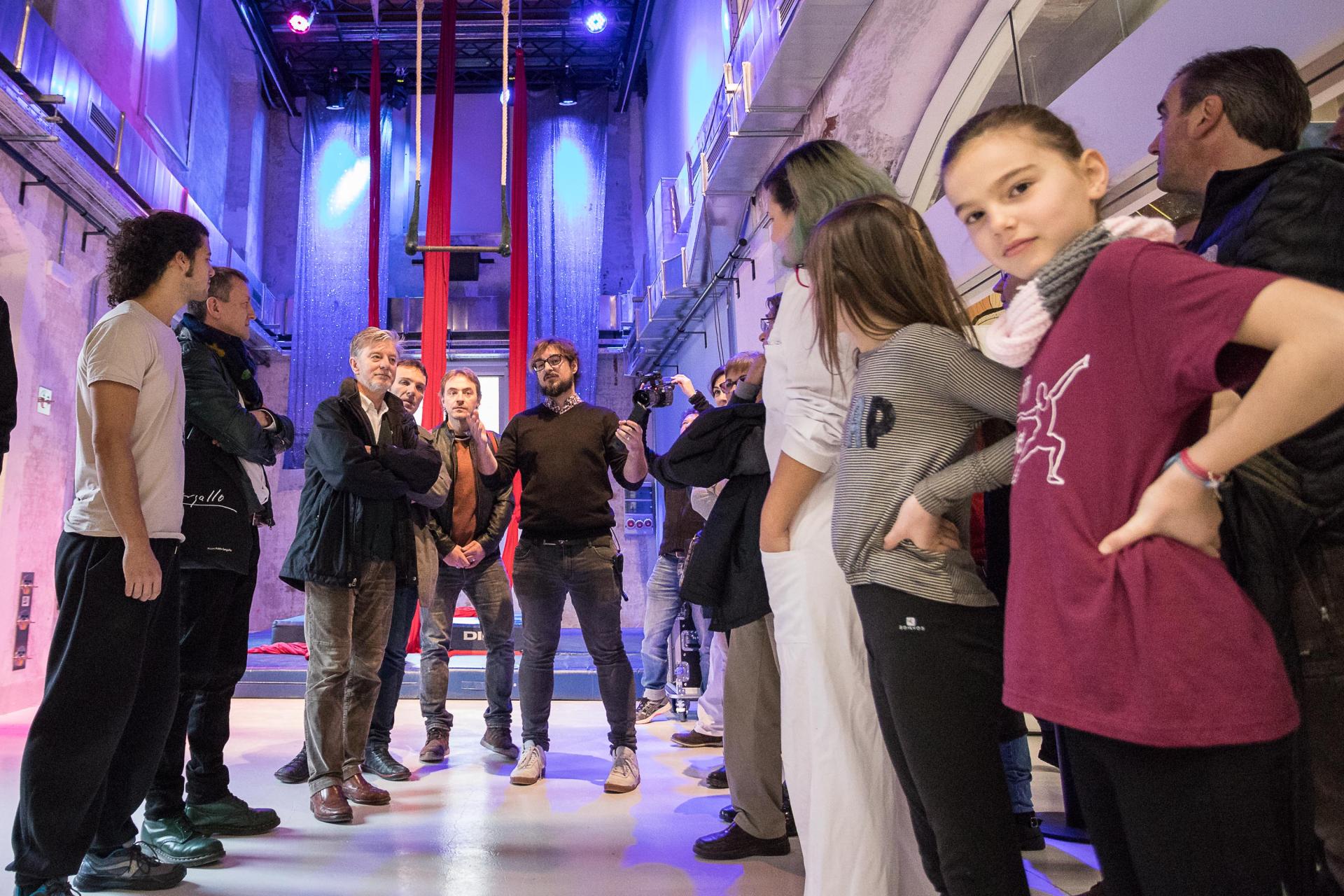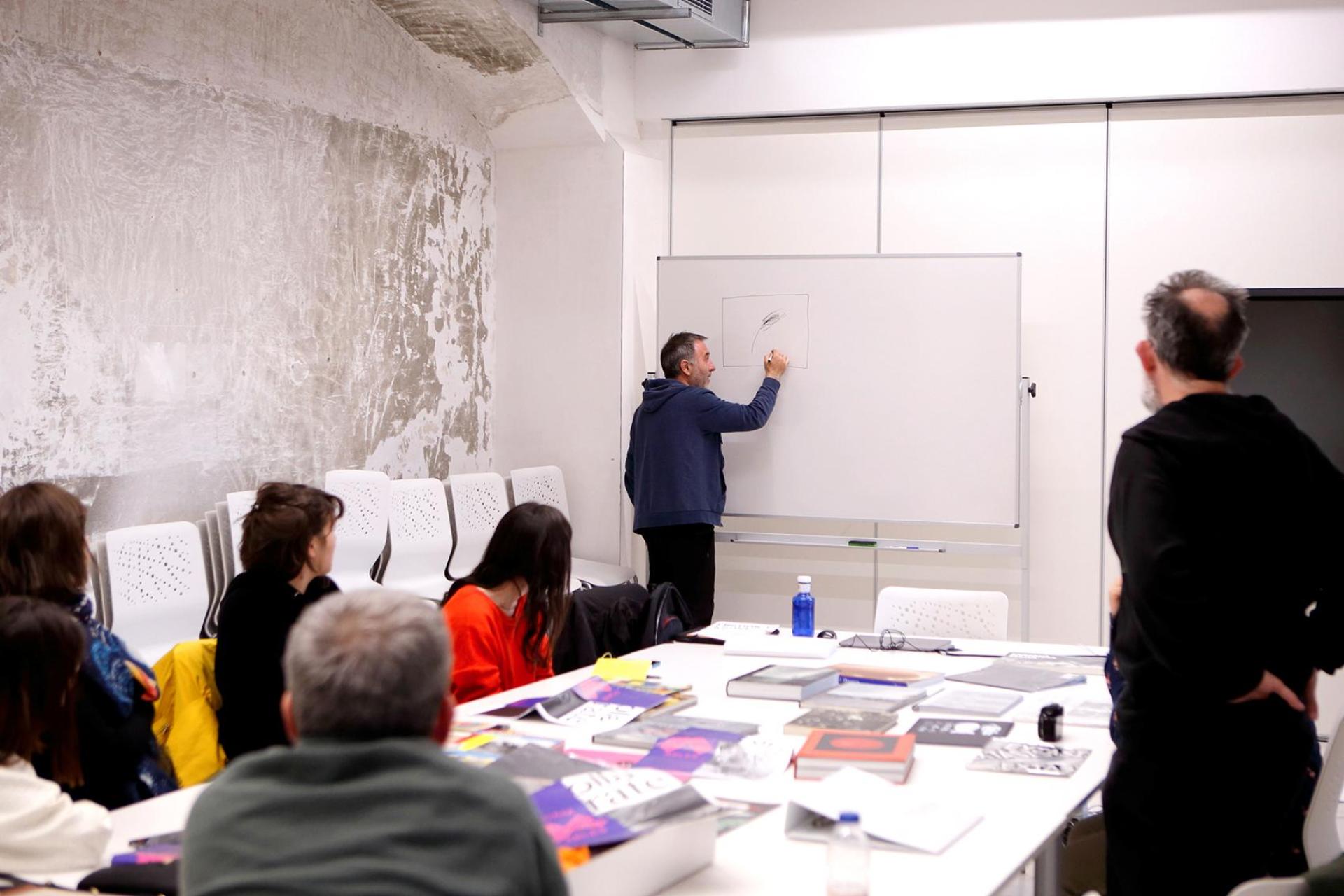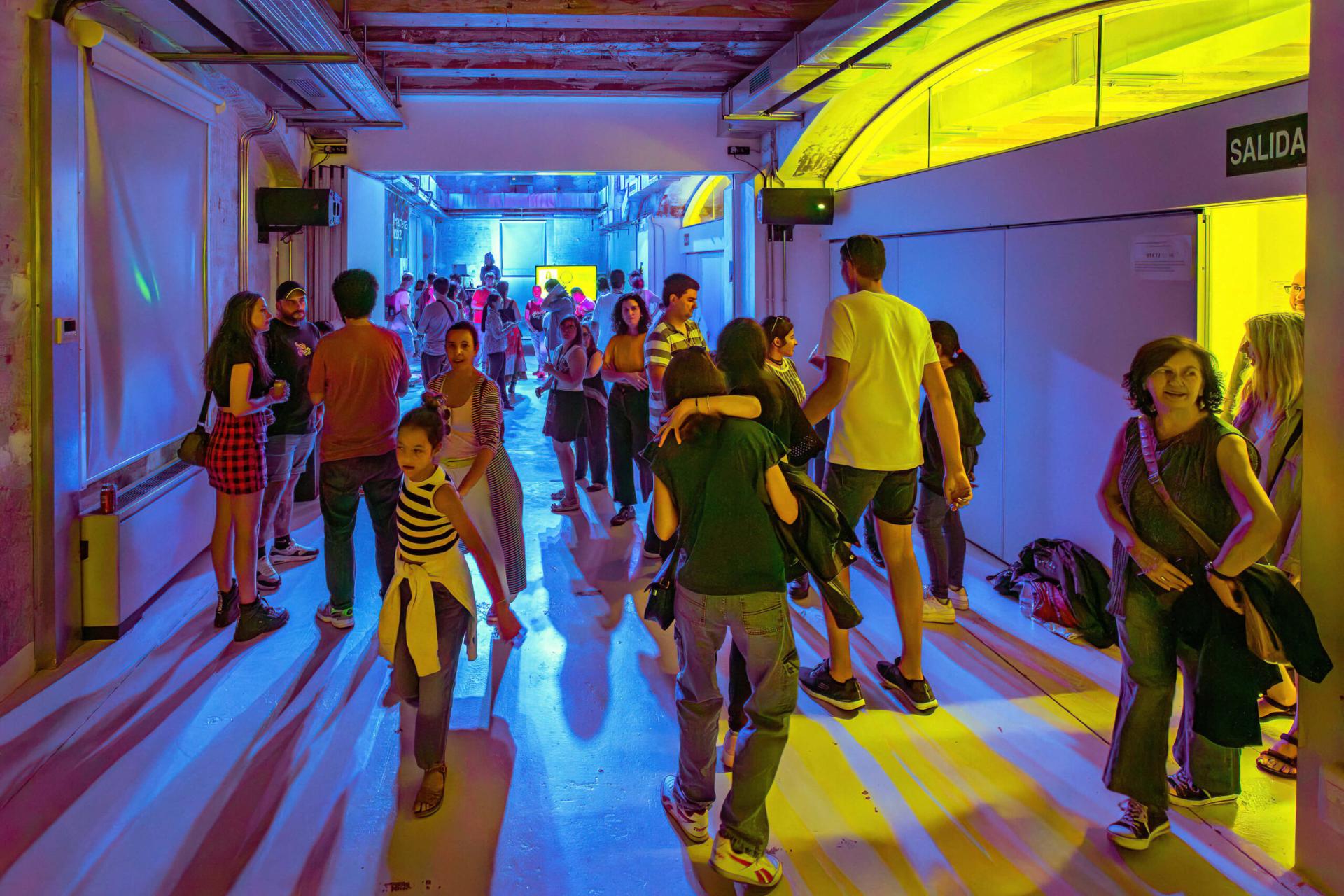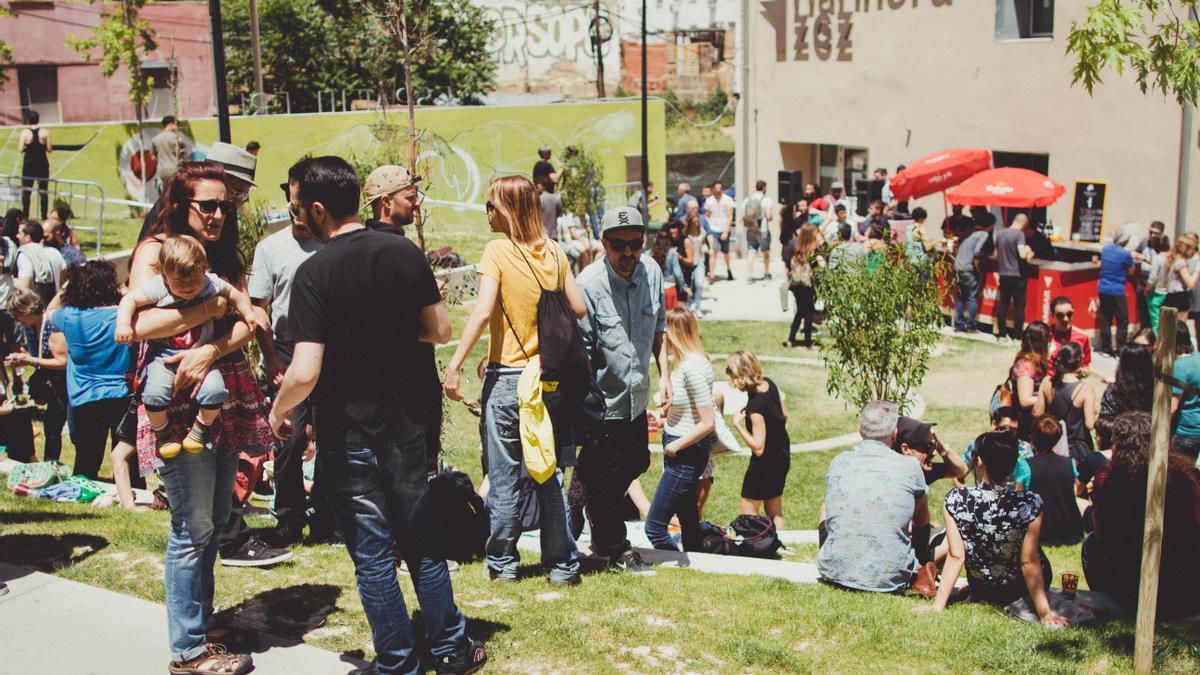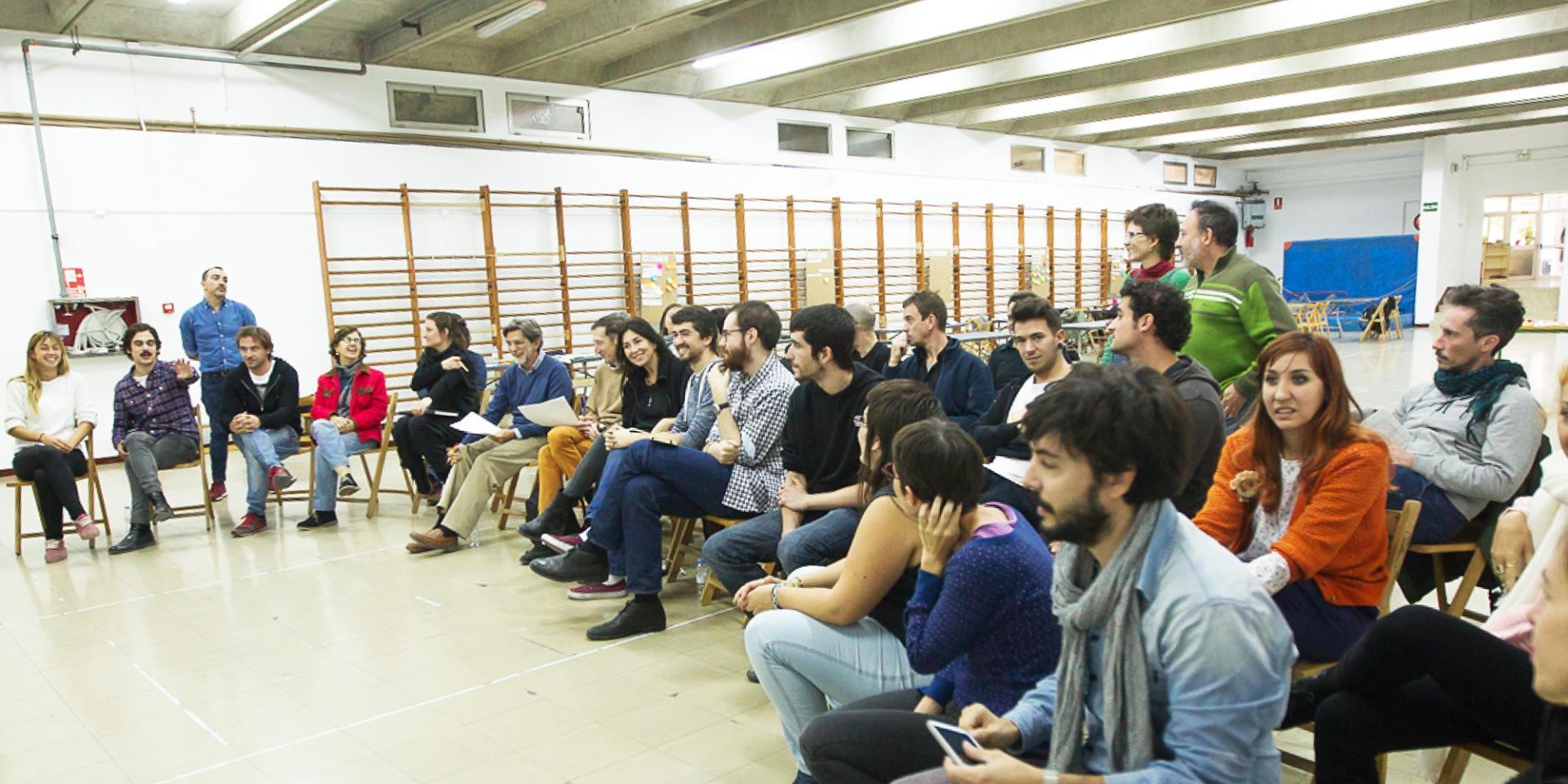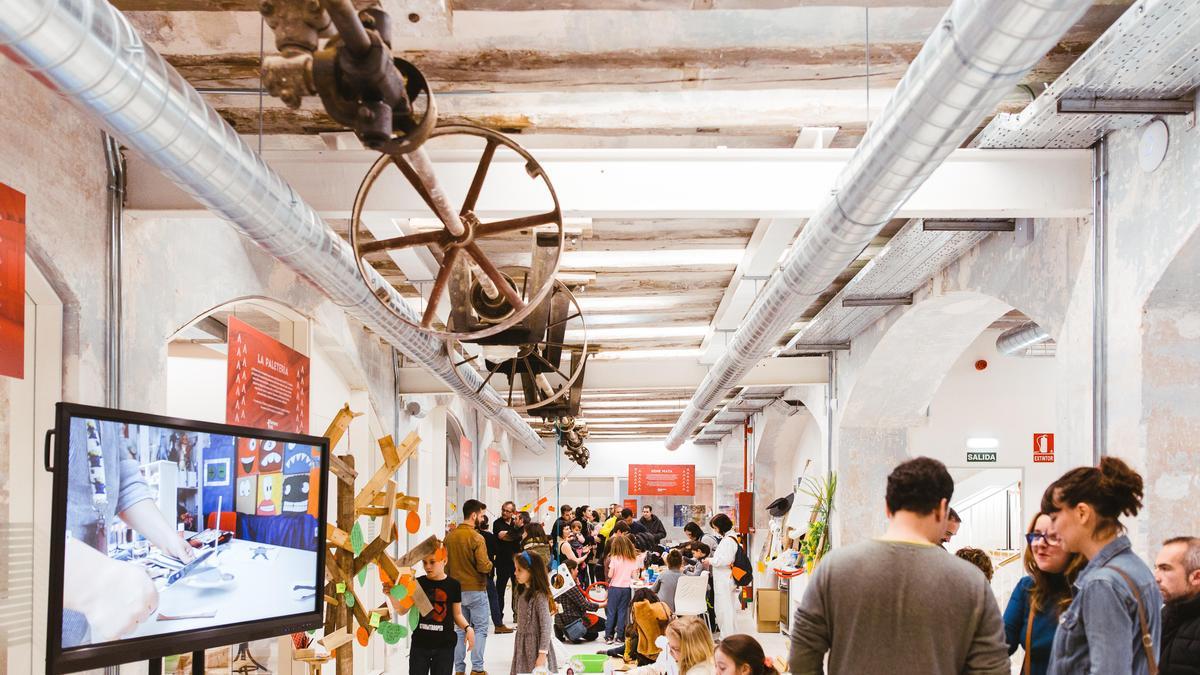Harinera ZGZ
Basic information
Project Title
Harinera ZGZ
Full project title
Harinera ZGZ, a space for community culture in the district of San José
Category
Prioritising the places and people that need it the most
Project Description
Harinera ZGZ is a community culture project based on public-community governance in which the public administration, the local community and cultural and social stakeholders co-manage cultural production through an assembly open to participation. Its central objective is the promotion of the right of access to culture in all its dimensions: that any person, regardless of their conditions, can not only consume, but also produce and decide their own culture.
Geographical Scope
Local
Project Region
Zaragoza, Spain
Urban or rural issues
Mainly urban
Physical or other transformations
It refers to other types of transformations (soft investment)
EU Programme or fund
Yes
Which funds
Creative Europe
Description of the project
Summary
Harinera ZGZ arose from a neighbourhood demand for the recovery of one of the last two industrial spaces in a district whose history is closely linked to the industrial developments in the south of Zaragoza. Faced with models of occupation, complete cession or exploitation by the administration, Zaragoza City Council decided to set up a participatory process to generate an open group with which to co-manage the space, giving rise to a space accessible to the citizens, in which they can not only consume culture, but also produce it and decide on the cultural offer of their city.
The project responds to a lack of cultural facilities in the peripheral neighbourhoods of the city, increasing and decentralising the cultural offer and broadening the understanding of what it means to create culture. The activity is centred around the creation of community culture, in which the processes of creation directly challenge all the parties involved and generate growth and an increase in the capacities of its members.
The activities developed around the project seek to raise awareness about the cultural fact, about material sustainability and recycling and reuse, encouraging the programming of activities that make use of existing elements for the creation of new objects. The aim is to promote environmental awareness, particularly among children and young people. Public tools for the repair and reuse of items are also made available to the population as a whole through open workshops.
Inclusion is the priority aspect within Harinera ZGZ, which seeks to make citizens actively participate in the consumption, production and cultural management that takes place in the space, openly and free of charge. The management of the space is carried out in open assemblies in which the administration, the local community and socio-cultural agents act and decide on equal terms, thus reinforcing the feeling of belonging and empathy towards public administrations.
The project responds to a lack of cultural facilities in the peripheral neighbourhoods of the city, increasing and decentralising the cultural offer and broadening the understanding of what it means to create culture. The activity is centred around the creation of community culture, in which the processes of creation directly challenge all the parties involved and generate growth and an increase in the capacities of its members.
The activities developed around the project seek to raise awareness about the cultural fact, about material sustainability and recycling and reuse, encouraging the programming of activities that make use of existing elements for the creation of new objects. The aim is to promote environmental awareness, particularly among children and young people. Public tools for the repair and reuse of items are also made available to the population as a whole through open workshops.
Inclusion is the priority aspect within Harinera ZGZ, which seeks to make citizens actively participate in the consumption, production and cultural management that takes place in the space, openly and free of charge. The management of the space is carried out in open assemblies in which the administration, the local community and socio-cultural agents act and decide on equal terms, thus reinforcing the feeling of belonging and empathy towards public administrations.
Key objectives for sustainability
One of the priority objectives of Harinera ZGZ is to support sustainability in all its dimensions, expanding the collaborative social economy to the city. One of the priority forms of cultural creation within Harinera ZGZ, which was reflected during the "Recyclaction" day of the participatory process around which the project was shaped. The day consisted of using abandoned objects to create new items of furniture that could fill the space of Harinera ZGZ.
This vocation for reduction, reuse and recycling has accompanied the Harinera ZGZ project throughout its existence, actively promoting activities centred on the efficiency and reuse of materials aimed at children and young people, both inside the building that normally houses the Harinera ZGZ project and outside it, in schools in the district in which it is located.
Another of Harinera ZGZ's priority objectives is to work for the cultural, social and urban regeneration of the neighbourhood and the city, which has led us to carry out projects to activate disused public spaces, as occurred during the "Gardinacción" (Gardaction) day of the initial participatory process, in which a public park located in the district of San José was filled with activities to recover activity and encourage the use of public space. At the same time, actions of temporary pedestrianisation of public space have been carried out, inviting the population to reflect on the possibilities of using our public space beyond the use of private and polluting vehicles.
We believe that facilitating and putting public resources at the service of citizens to guarantee the right to repair and the right to a public space free of traffic are replicable elements of Harinera ZGZ and essential to achieve a just ecological transition in our cities.
This vocation for reduction, reuse and recycling has accompanied the Harinera ZGZ project throughout its existence, actively promoting activities centred on the efficiency and reuse of materials aimed at children and young people, both inside the building that normally houses the Harinera ZGZ project and outside it, in schools in the district in which it is located.
Another of Harinera ZGZ's priority objectives is to work for the cultural, social and urban regeneration of the neighbourhood and the city, which has led us to carry out projects to activate disused public spaces, as occurred during the "Gardinacción" (Gardaction) day of the initial participatory process, in which a public park located in the district of San José was filled with activities to recover activity and encourage the use of public space. At the same time, actions of temporary pedestrianisation of public space have been carried out, inviting the population to reflect on the possibilities of using our public space beyond the use of private and polluting vehicles.
We believe that facilitating and putting public resources at the service of citizens to guarantee the right to repair and the right to a public space free of traffic are replicable elements of Harinera ZGZ and essential to achieve a just ecological transition in our cities.
Key objectives for aesthetics and quality
A priority objective of Harinera ZGZ is to produce culture by getting its hands dirty, promoting experimentation and cultural creation. To this end, the Programming Committee, which decides the programming that takes place through Harinera ZGZ in a way that is open to citizen participation and co-government with the public administration and the local community, carries out its task by encouraging innovative cultural projects in the city, seeking not to compete with other spaces that offer common cultural activities. At the same time, Harinera ZGZ does not hold exhibitions, unless the exhibits come from activities carried out within the same project, giving greater projection to cultural innovation and community cultural processes that are developed.
The type of cultural creation that is prioritised in Harinera ZGZ is that of community culture, through which the process of creation and collaboration between the different parts of the creative community has a high value in itself, allowing the interrelation between types of people who otherwise would not interact, promoting personal growth and the development of skills of the participants and achieving social improvement through culture. Although the final product is not the main raison d'être of this form of cultural creation, they are often valuable elements, not only for their aesthetic quality, but also for being representative of these processes.
We believe that the horizontality around cultural creation and the capacity for social transformation that community culture creation has are intrinsic elements of Harinera ZGZ that could be replicated, and in fact are being replicated, in a large part of Europe. In turn, we believe that the co-governance model of Harinera ZGZ is consistent with this form of cultural creation, fostering and enhancing all its virtues.
The type of cultural creation that is prioritised in Harinera ZGZ is that of community culture, through which the process of creation and collaboration between the different parts of the creative community has a high value in itself, allowing the interrelation between types of people who otherwise would not interact, promoting personal growth and the development of skills of the participants and achieving social improvement through culture. Although the final product is not the main raison d'être of this form of cultural creation, they are often valuable elements, not only for their aesthetic quality, but also for being representative of these processes.
We believe that the horizontality around cultural creation and the capacity for social transformation that community culture creation has are intrinsic elements of Harinera ZGZ that could be replicated, and in fact are being replicated, in a large part of Europe. In turn, we believe that the co-governance model of Harinera ZGZ is consistent with this form of cultural creation, fostering and enhancing all its virtues.
Key objectives for inclusion
Harinera ZGZ actively seeks to promote and develop citizen participation and personal and collective empowerment. All the ways in which the population can participate in the project encourage this participation and inclusion.
By participating as a user, the vast majority of the activities promoted by Harinera ZGZ are framed within the framework of community cultural creation, in which the user rarely simply consumes culture, but participates in the process of creation, encompassing many and diverse artistic disciplines such as graphic arts, ceramic sculpture, dance, theatre or music. Furthermore, the vast majority of the activities that take place at Harinera ZGZ are free and designed with diverse audiences in mind, not only in terms of age or gender, but also in terms of physical and mental diversity, ensuring accessibility to culture for the whole population.
When proposing an activity to be carried out within Harinera ZGZ, the process of proposing activities or requesting a space is completely transparent, and the person or organisation proposing the activity can even be part of the decision-making process in which the project's budget is distributed to finance the activities and schedule them every four months.
By participating in the management of programming, communication or the relationship with the environment through its assembly and its working groups, any citizen can act with a voice and vote in the deliberative processes that take place in Harinera ZGZ, being not only a space in which to enjoy and learn culture, but also a school of coexistence and learning about the functioning and mechanisms of public administration.
We believe that this broad understanding of the right to culture is the main value of Harinera ZGZ, which permeates all its layers and spaces, and that the model is applicable to all public administrations and civil society organisations.
By participating as a user, the vast majority of the activities promoted by Harinera ZGZ are framed within the framework of community cultural creation, in which the user rarely simply consumes culture, but participates in the process of creation, encompassing many and diverse artistic disciplines such as graphic arts, ceramic sculpture, dance, theatre or music. Furthermore, the vast majority of the activities that take place at Harinera ZGZ are free and designed with diverse audiences in mind, not only in terms of age or gender, but also in terms of physical and mental diversity, ensuring accessibility to culture for the whole population.
When proposing an activity to be carried out within Harinera ZGZ, the process of proposing activities or requesting a space is completely transparent, and the person or organisation proposing the activity can even be part of the decision-making process in which the project's budget is distributed to finance the activities and schedule them every four months.
By participating in the management of programming, communication or the relationship with the environment through its assembly and its working groups, any citizen can act with a voice and vote in the deliberative processes that take place in Harinera ZGZ, being not only a space in which to enjoy and learn culture, but also a school of coexistence and learning about the functioning and mechanisms of public administration.
We believe that this broad understanding of the right to culture is the main value of Harinera ZGZ, which permeates all its layers and spaces, and that the model is applicable to all public administrations and civil society organisations.
Results in relation to category
Harinera ZGZ programmes more than 200 activities every year, some of them over a long period of time, aimed at diverse and in many cases vulnerable populations. Through the different forms of participation that Harinera ZGZ contemplates (user, programmer or manager), more than 22,000 people have participated in Harinera ZGZ since March 2016, with an active driving group of around 50 people.
Since its opening, Harinera ZGZ has won the Eurocities 2019 award in the Participation category, has been part of the Adeste+ project, co-funded by the Creative Europe Programme and has developed the project "Thinking an H" with funding from the Daniel and Nina Carasso Foundation, within its call "Alliances for a cultural democracy 2020".
Many organisations and city councils have contacted us to participate in their conferences, with the intention of learning more about the Harinera ZGZ project, and in some cases with the intention of replicating it in their city. In total we have participated in 30 conferences or events, of which we would highlight our participation in the III Encuentro Cultura y Ciudadanía organised by the Ministry of Education, Culture and Sport in Madrid in 2017, the Jornadas Internacionales de Acción Comunitaria organised by the Ayuntamiento de Barcelona y Escuela de la IGOP (Instituto de Gobierno y Políticas Públicas, Universidad Autónoma de Barcelona) in 2018, the III Jornadas de Descentralización, Reequilibrio Territorial y Cooperación Público- Social organised by Madrid City Council in 2019, the Jornada Redes y Comunidades Experiencias organised by Planalab UJI (Universitat Jaume I) in 2020, the conversatorio proceso de codiseño de los Laboratorios Ciudadanos organised by Las Naves Valencia and CARPE in 2021 or Culturópolis: Jornadas internacionales por los derechos culturales organised by Barcelona City Council in 2022.
Since its opening, Harinera ZGZ has won the Eurocities 2019 award in the Participation category, has been part of the Adeste+ project, co-funded by the Creative Europe Programme and has developed the project "Thinking an H" with funding from the Daniel and Nina Carasso Foundation, within its call "Alliances for a cultural democracy 2020".
Many organisations and city councils have contacted us to participate in their conferences, with the intention of learning more about the Harinera ZGZ project, and in some cases with the intention of replicating it in their city. In total we have participated in 30 conferences or events, of which we would highlight our participation in the III Encuentro Cultura y Ciudadanía organised by the Ministry of Education, Culture and Sport in Madrid in 2017, the Jornadas Internacionales de Acción Comunitaria organised by the Ayuntamiento de Barcelona y Escuela de la IGOP (Instituto de Gobierno y Políticas Públicas, Universidad Autónoma de Barcelona) in 2018, the III Jornadas de Descentralización, Reequilibrio Territorial y Cooperación Público- Social organised by Madrid City Council in 2019, the Jornada Redes y Comunidades Experiencias organised by Planalab UJI (Universitat Jaume I) in 2020, the conversatorio proceso de codiseño de los Laboratorios Ciudadanos organised by Las Naves Valencia and CARPE in 2021 or Culturópolis: Jornadas internacionales por los derechos culturales organised by Barcelona City Council in 2022.
How Citizens benefit
The involvement of citizens and civil society in Harinera ZGZ is total, as has been explained above, individual or collective involvement can take place in all parts of the project, ensuring the right to culture and broadening the understanding of this right not only as consumption, but also as production and management.
On many occasions, the population that participates in Harinera ZGZ's community culture processes are people in situations of vulnerability, with different approaches. People with psychic diversity participate in the cultural co-creation of graphic art pieces in processes such as those developed in "Andar de Nones", non-Spanish-speaking migrants participate in the creation of murals in processes such as those developed in "Artebrije", young people in situations of socio-economic vulnerability participate in the musical creation processes of "Orquesta Escuela" and a mainly feminised population participates in the community textile creation of "Mottainai", to give just a few examples. All these groups participate free of charge in processes housed within Harinera ZGZ and in some cases financed by the project, guaranteeing their right to access to culture, their empowerment and their interaction with other population groups, which benefits their physical and emotional wellbeing.
In turn, the participation of these groups as users of the cultural processes developed in Harinera ZGZ mutually nourishes the different initiatives, which permeates all the layers of the project, making the selection processes in the four-monthly programme more sensitive to the barriers that these groups face when participating in cultural processes and their specific needs.
Within the Adeste+ project, co-financed by the Creative Europe Programme, the young population, often left out of the city's cultural activities, has also been involved, encouraging their empowerment for the promotion of activities and carrying out accompaniment within Harinera ZGZ.
On many occasions, the population that participates in Harinera ZGZ's community culture processes are people in situations of vulnerability, with different approaches. People with psychic diversity participate in the cultural co-creation of graphic art pieces in processes such as those developed in "Andar de Nones", non-Spanish-speaking migrants participate in the creation of murals in processes such as those developed in "Artebrije", young people in situations of socio-economic vulnerability participate in the musical creation processes of "Orquesta Escuela" and a mainly feminised population participates in the community textile creation of "Mottainai", to give just a few examples. All these groups participate free of charge in processes housed within Harinera ZGZ and in some cases financed by the project, guaranteeing their right to access to culture, their empowerment and their interaction with other population groups, which benefits their physical and emotional wellbeing.
In turn, the participation of these groups as users of the cultural processes developed in Harinera ZGZ mutually nourishes the different initiatives, which permeates all the layers of the project, making the selection processes in the four-monthly programme more sensitive to the barriers that these groups face when participating in cultural processes and their specific needs.
Within the Adeste+ project, co-financed by the Creative Europe Programme, the young population, often left out of the city's cultural activities, has also been involved, encouraging their empowerment for the promotion of activities and carrying out accompaniment within Harinera ZGZ.
Physical or other transformations
It refers to other types of transformations (soft investment)
Innovative character
The management model of Harinera ZGZ is unique in its conception. In contrast to models of totally public or totally private management, and even models in which the public administration collaborates with civil society groups on an ad hoc basis to manage spaces, Harinera ZGZ is a project in which the three parties that make up the assembly, the public administration, the local community and the open group of socio-cultural agents, collaborate closely and on equal terms from the start of the project.
Harinera ZGZ introduces an important and unique innovation at a time when the main mandate of public cultural institutions is to guarantee the full right of access to culture for everyone. This mandate becomes complicated when these institutions, weighed down by rigidity, vertigo in the face of uncertainty or lack of mechanisms, try to put it into practice. We believe that Harinera ZGZ directly challenges public cultural managers, reconverting their work towards an exercise based on mediation, facilitating spaces and processes from which to explore models of shared governance that give agency to communities in the production and decision-making in culture.
It is, therefore, a project that has rethought and diluted the barrier between the public and the community, offering a replicable framework from which to open up new spaces for participation, cultural democracy and accessibility. To this end, it is essential to assume the conflict that this type of shared governance proposes, understood in the most positive sense of the word, putting people, collectives and public administrations in relation, accepting that the day-to-day running of projects of this profile means putting the institution under tension, regularly confronting it with its contradictions and shortcomings.
Harinera ZGZ introduces an important and unique innovation at a time when the main mandate of public cultural institutions is to guarantee the full right of access to culture for everyone. This mandate becomes complicated when these institutions, weighed down by rigidity, vertigo in the face of uncertainty or lack of mechanisms, try to put it into practice. We believe that Harinera ZGZ directly challenges public cultural managers, reconverting their work towards an exercise based on mediation, facilitating spaces and processes from which to explore models of shared governance that give agency to communities in the production and decision-making in culture.
It is, therefore, a project that has rethought and diluted the barrier between the public and the community, offering a replicable framework from which to open up new spaces for participation, cultural democracy and accessibility. To this end, it is essential to assume the conflict that this type of shared governance proposes, understood in the most positive sense of the word, putting people, collectives and public administrations in relation, accepting that the day-to-day running of projects of this profile means putting the institution under tension, regularly confronting it with its contradictions and shortcomings.
Disciplines/knowledge reflected
During the initial participatory process, which took place between September 2014 and March 2016, until the space that normally houses Harinera ZGZ was opened, public workers from the cultural sector, architects, visual and audiovisual artists, cultural managers, communication specialists, graphic design and creative self-construction and recycling professionals, musicians, performing arts professionals and representatives of the local community took part.
This panoply of agents gave the participatory process a breadth of knowledge that was reflected in the decisions on the design and use of the spaces of the renovated industrial building that houses Harinera ZGZ, on the management, programming and communication model that the building would have, and on the different actions that were carried out during the participatory process to disseminate and co-design the project.
Some of the dynamics that were developed to exploit this variety of knowledge was the realisation of a 'speed dating' in which different agents engaged in short conversations in pairs to arrive at projects that could be developed in common, encouraging experimentation and cultural innovation and the creation of networks and relationships between the different agents.
After the completion of the participatory process, other disciplines have been added, such as sociology, specialisation in heritage, ceramics or textile work, resulting in a greater number of synergies and allowing aspects such as the gender perspective, which were not dealt with so intensely within the project, to be worked on, resulting, for example, in a diagnosis of Harinera ZGZ with a gender perspective.
The project 'Pensar una H', carried out with funding from the Daniel and Nina Carasso Foundation, highlighted the different concerns of the agents involved in the project and established goals to be worked on in the future on issues such as the social economy, accessibility and the relationship with its neighbourhood.
This panoply of agents gave the participatory process a breadth of knowledge that was reflected in the decisions on the design and use of the spaces of the renovated industrial building that houses Harinera ZGZ, on the management, programming and communication model that the building would have, and on the different actions that were carried out during the participatory process to disseminate and co-design the project.
Some of the dynamics that were developed to exploit this variety of knowledge was the realisation of a 'speed dating' in which different agents engaged in short conversations in pairs to arrive at projects that could be developed in common, encouraging experimentation and cultural innovation and the creation of networks and relationships between the different agents.
After the completion of the participatory process, other disciplines have been added, such as sociology, specialisation in heritage, ceramics or textile work, resulting in a greater number of synergies and allowing aspects such as the gender perspective, which were not dealt with so intensely within the project, to be worked on, resulting, for example, in a diagnosis of Harinera ZGZ with a gender perspective.
The project 'Pensar una H', carried out with funding from the Daniel and Nina Carasso Foundation, highlighted the different concerns of the agents involved in the project and established goals to be worked on in the future on issues such as the social economy, accessibility and the relationship with its neighbourhood.
Methodology used
The Harinera ZGZ project is based on equality between the different parties involved in the project, so much so that the participatory process was not led by the public administration, but rather a team specialised in participatory processes (Paisaje Transversal) was hired to design and lead the different interactions and dynamics, ensuring that the City Council participated as another agent.
Within this process, during which bi-weekly meetings were held involving the public administration, the local community and the open group of socio-cultural agents, the management model, the nature of the project, the objectives and even the image of the Harinera ZGZ project were discussed and decided upon. At the same time, three activities were carried out, open and widely communicated, with two main objectives: to attract more citizens to the open group of socio-cultural agents and to demonstrate three essential aspects of the project: active participation in the design of the spaces and projects linked to Harinera ZGZ, creative recycling and urban transformation through cultural creation.
After the initial participatory process, Harinera ZGZ is managed through an assembly made up of representatives of the City Council, the local community and the open group of socio-cultural agents, in which all aspects related to Harinera ZGZ are decided, from communication campaigns to budget distribution, including the configuration of the cultural programme for each four-month period or participation in conferences or events to which we are invited. For the more specific development of each of the topics worked on in Harinera ZGZ, there is a working group, again open and with representation from the three aforementioned parties.
The presentation of proposals to be developed and promoted within Harinera ZGZ is also open, following a common methodology for all citizens and professionals and decided in meetings open to the whole population.
Within this process, during which bi-weekly meetings were held involving the public administration, the local community and the open group of socio-cultural agents, the management model, the nature of the project, the objectives and even the image of the Harinera ZGZ project were discussed and decided upon. At the same time, three activities were carried out, open and widely communicated, with two main objectives: to attract more citizens to the open group of socio-cultural agents and to demonstrate three essential aspects of the project: active participation in the design of the spaces and projects linked to Harinera ZGZ, creative recycling and urban transformation through cultural creation.
After the initial participatory process, Harinera ZGZ is managed through an assembly made up of representatives of the City Council, the local community and the open group of socio-cultural agents, in which all aspects related to Harinera ZGZ are decided, from communication campaigns to budget distribution, including the configuration of the cultural programme for each four-month period or participation in conferences or events to which we are invited. For the more specific development of each of the topics worked on in Harinera ZGZ, there is a working group, again open and with representation from the three aforementioned parties.
The presentation of proposals to be developed and promoted within Harinera ZGZ is also open, following a common methodology for all citizens and professionals and decided in meetings open to the whole population.
How stakeholders are engaged
Harinera ZGZ is a project that is co-managed in a public-community way through an assembly held every two weeks and working groups that carry out the day-to-day tasks of the project. All these management bodies are made up of representatives from the City Council, through the municipal company Zaragoza Cultural, the local community, through the Neighbourhood Association of the San José neighbourhood and associations of mothers and fathers of pupils from the district's schools, and an open group of socio-cultural agents in which any citizen can participate.
This management model has largely benefited all three parties. The City Council has been able to experiment with new management models and has become aware of the potential of community culture as a form of social improvement and transformation through culture, which has materialised in the inclusion of a Community Culture Sectoral Committee within the Culture Sectoral Council, this being the main body for citizen participation, debate, monitoring, evaluation and accountability at municipal level in the field of culture. The local community has seen an increase in the cultural offer in the district, which is also accessible to the entire population. This increased offer has not only taken place within the building that normally houses the Harinera ZGZ project, but also activities have been carried out from Harinera ZGZ in different spaces of the district during festivals, cultural weeks or other relevant events of the district and even the city. The socio-cultural agents participating in Harinera ZGZ have been able to develop their activities around community culture, having the opportunity to participate in municipal governance spaces, increasing their knowledge of the municipal administration and increasing their empathy towards it. In turn, the collaboration of different agents under the same project has led to numerous collaborations of different agents outside the framework of Harinera ZGZ.
This management model has largely benefited all three parties. The City Council has been able to experiment with new management models and has become aware of the potential of community culture as a form of social improvement and transformation through culture, which has materialised in the inclusion of a Community Culture Sectoral Committee within the Culture Sectoral Council, this being the main body for citizen participation, debate, monitoring, evaluation and accountability at municipal level in the field of culture. The local community has seen an increase in the cultural offer in the district, which is also accessible to the entire population. This increased offer has not only taken place within the building that normally houses the Harinera ZGZ project, but also activities have been carried out from Harinera ZGZ in different spaces of the district during festivals, cultural weeks or other relevant events of the district and even the city. The socio-cultural agents participating in Harinera ZGZ have been able to develop their activities around community culture, having the opportunity to participate in municipal governance spaces, increasing their knowledge of the municipal administration and increasing their empathy towards it. In turn, the collaboration of different agents under the same project has led to numerous collaborations of different agents outside the framework of Harinera ZGZ.
Global challenges
There are two overarching problems, both interrelated and of broad relevance in today's political sphere. On the one hand, there is a growing distrust on the part of citizens towards public administrations in general and political leaders in particular, resulting in attacks on representative elements of the administration or political parties such as those that have occurred recently in the United States, Brazil or Spain. Allowing active participation in administrative processes, making them part of governance and even ceding them part of the control over elements of public administration, encourages this participating population to be more aware of the logics and processes on which our democracies are based, increasing citizens' empathy towards administrations, and making administrations more aware of the concrete problems faced by the population. This model has been widely investigated through the Citizens' Assemblies, but we consider that the co-management model of Harinera ZGZ offers a more lasting solution in which the beneficial impact for citizens and administrations is greater.
The second problem, partially linked to the first, is the inability of a large part of the population to access culture, in all its forms. This inaccessibility may be due to various barriers, such as income, the profiles at which the cultural offer is aimed or the lack of spaces in which to develop these cultural processes. Harinera ZGZ is an example of a project in which the public administration puts the necessary resources at the service of the population so that they can develop their diverse cultural concerns in an open and participatory way.
The second problem, partially linked to the first, is the inability of a large part of the population to access culture, in all its forms. This inaccessibility may be due to various barriers, such as income, the profiles at which the cultural offer is aimed or the lack of spaces in which to develop these cultural processes. Harinera ZGZ is an example of a project in which the public administration puts the necessary resources at the service of the population so that they can develop their diverse cultural concerns in an open and participatory way.
Learning transferred to other parties
The process through which Harinera ZGZ was developed, as well as its organisational model, can be widely replicated, and all the documentation on both is published on the website provided in the application.
In the case of Harinera ZGZ, it is a governance model applied mainly to cultural activities and programming, but we believe that the active participation developed in the space should be replicated to cover other fields, in which the population normally has less capacity to influence, such as housing, the environment or urban planning. The creation of these public-community structures, in which the administration participates as another agent, is necessary to ensure essential elements of any democracy, such as accountability and the proximity of those in power to the population.
Other replicable aspects of Harinera ZGZ, which we have not had space to develop, is the management model of the project's residences, whose call is based on the return of free cultural activities to the district of San José and the city of Zaragoza in exchange for the use of spaces inside the renovated industrial building.
In the case of Harinera ZGZ, it is a governance model applied mainly to cultural activities and programming, but we believe that the active participation developed in the space should be replicated to cover other fields, in which the population normally has less capacity to influence, such as housing, the environment or urban planning. The creation of these public-community structures, in which the administration participates as another agent, is necessary to ensure essential elements of any democracy, such as accountability and the proximity of those in power to the population.
Other replicable aspects of Harinera ZGZ, which we have not had space to develop, is the management model of the project's residences, whose call is based on the return of free cultural activities to the district of San José and the city of Zaragoza in exchange for the use of spaces inside the renovated industrial building.
Keywords
Community culture
Empowerment
Public-community governance
Cultural decentralization
Cultural Rights

